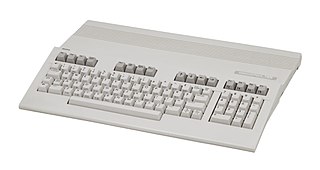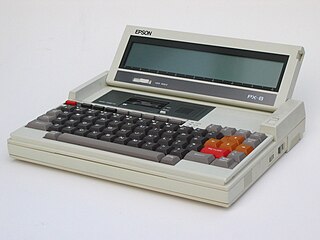
The TRS-80 Micro Computer System is a desktop microcomputer launched in 1977 and sold by Tandy Corporation through their Radio Shack stores. The name is an abbreviation of Tandy Radio Shack, Z80 [microprocessor]. It is one of the earliest mass-produced and mass-marketed retail home computers.
Psion Organiser was the brand name of a range of pocket computers developed by the British company Psion in the 1980s. The Organiser I and Organiser II had a characteristic hard plastic sliding cover protecting a 6×6 keypad instead of a computer keyboard, with letters arranged alphabetically.

The Commodore 128, also known as the C128, C-128, or C= 128, is the last 8-bit home computer that was commercially released by Commodore Business Machines (CBM). Introduced in January 1985 at the CES in Las Vegas, it appeared three years after its predecessor, the Commodore 64, the bestselling computer of the 1980s.

The Commodore PET is a line of personal computers produced starting in 1977 by Commodore International. A single all-in-one case combines a MOS Technology 6502 microprocessor, Commodore BASIC in read-only memory, keyboard, monochrome monitor, and, in early models, a cassette deck.

The IBM PC Convertible is a laptop computer made by IBM, first sold in April 1986. The Convertible was IBM's first laptop-style computer, following the luggable IBM Portable, and introduced the 3½-inch floppy disk format to the IBM product line. Like modern laptops, it featured power management and the ability to run from batteries.

The Commodore Plus/4 is a home computer released by Commodore International in 1984. The "Plus/4" name refers to the four-application ROM-resident office suite ; it was billed as "the productivity computer with software built in".

The TRS-80 Model 100 is a portable computer introduced in April 1983. It is one of the first notebook-style computers, featuring a keyboard and liquid-crystal display, in a battery-powered package roughly the size and shape of a notepad or large book. The 224-page, spiral-bound User Manual is nearly the same size as the computer itself.

The Morrow Pivot II, released in May 1985, was a portable personal computer 100% compatible with IBM PC Software. It was designed by Norman Towson and Micheal Stolowitz, and manufactured by Morrow Designs - based on the Pivot designed by Vadem Inc. With one drive, 256 KB RAM, and a monochrome backlit LCD, the Pivot II had a list price of US$1,995.

The Data General/One (DG-1) was a laptop introduced in 1984 by Data General.

The Epson PX-8 a.k.a. Geneva was a small laptop computer made by the Epson Corporation in the mid-1980s.

The Apricot Portable was a personal computer manufactured by ACT Ltd., and was released to the public in November 1984. It was ACT's first attempt at manufacturing a portable computer, which were gaining popularity at the time. Compared to other portable computers of its time like the Compaq Portable and the Commodore SX-64, the Apricot Portable was the first system to have an 80-column and 25-line LCD screen and the first with a speech recognition system.

The Gavilan SC is a laptop computer that was the first ever to be marketed as a "laptop". The computer ran on an Intel 8088 microprocessor running at 5 MHz and sported a touchpad for a pointing device, one of the first computers to do so. The laptop was developed by Manuel "Manny" Fernandez and released by the Gavilan Computer Corporation, the company he founded and owned, in May 1983.

The Sharp PC-5000 was a pioneering laptop computer, announced by Sharp Corporation of Japan in November 1983. It employed a clamshell design in which the display closes over the keyboard, like the earlier GRiD Compass and contemporary Gavilan SC.

The Epson HX-20 was the first "true" laptop computer. It was invented in July 1980 by Yukio Yokozawa, who worked for Suwa Seikosha, a branch of Japanese company Seiko, receiving a patent for the invention. It was announced in 1981 as the HC-20 in Japan, and was introduced by Epson in North America as the HX-20 at the 1981 COMDEX computer show in Las Vegas, where it drew significant attention for its portability. It had a mass-market release in July 1982, as the HC-20 in Japan and as the Epson HX-20 in North America. The size of an A4 notebook and weighing 1.6 kg, it was hailed by BusinessWeek magazine as the "fourth revolution in personal computing".

The history of laptops describes the efforts, begun in the 1970s, to build small, portable Personal Computers that combine the components, inputs, outputs and capabilities of a Desktop Computer in a small chassis.

The Hewlett-Packard HP 110 is an MS-DOS compatible portable computer released in 1984. It uses a Harris 80C86 running at 5.33 MHz with 272 KB of RAM. It has an 80 character by 16 line monochrome liquid crystal display, runs MS-DOS 2.11 in ROM, and has the application programs MemoMaker, Terminal Emulator and Lotus 1-2-3 in ROM.

The RoadRunner was an early laptop computer designed by MicroOffice Systems Technology and introduced in 1983. Weighing roughly 5 pounds (2.3 kg) and featuring a battery able to power it for up to eight hours, the RoadRunner was one of the first clamshell notebook computers ever released.

The Executive Partner is an IBM PC-compatible portable computer that was introduced by the Panasonic Corporation in 1985. The portable computer is AC-powered exclusively, weighs between 28 and 30 pounds (14 kg), and features a built-in printer. The Executive Partner was one of the first affordable portable computers with a plasma display.
Athena Computer & Electronic Systems was an American computer company active from 1982 to 1987 and based in San Juan Capistrano, California. It released an early laptop, the Athena 1, in 1983. The laptop was one of the first to make use of solid-state technology as its primary storage medium.


















